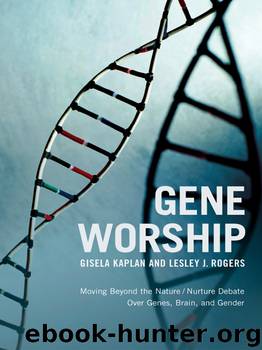Gene Worship by Gisela Kaplan

Author:Gisela Kaplan [Kaplan, Gisela; Rogers, Lesley J.]
Language: eng
Format: epub
ISBN: 978-1-59051-452-8
Publisher: Other Press
Published: 2003-03-14T16:00:00+00:00
PART THREE
In Perpetuity
When nature formed you, she doubted for a moment
Whether to offer you as a girl or a boy,
While she sets her mind’s eye to settling this,
Behold! You come forth, born as a vision for all.
Hilary the Englishman
(twelfth-century English poet)
7
Designated Sex Development
GODS, GODDESSES, AND MALE AND FEMALE COMPETITION
The designation of who is female and who is male is inextricably linked to a long-raging battle over the relative evolutionary importance of female and male. Formerly, the battle was fought in cults and religious beliefs. Today, in a secularized world, it has been shifted largely to science and to molecular levels. Broadly, social organization and relative role accommodation of the sexes has tended to be in tune with beliefs of the role of the egg and the sperm. In prehistoric times, women were often placed on pedestals as symbols of fertility. Matriarchies tended to be associated with the belief that the entire role of reproduction rested with women. The discovery of the sperm as an important contributor to reproduction wrested power away from women but not immediately and not entirely.
Throughout many centuries, goddesses of fertility were revered around the world. Those in Asia Minor and Middle Eastern countries eventually found their way to Europe (first Greece and then Rome). There were male gods and female gods side by side, but goddesses of fertility were central to many spiritual beliefs. For instance, the legend of Attis tells of a young shepherd much beloved by the goddess Cybele, who was not just any goddess but the mother of all gods, and was said to have her home in Phrygia. The various remnants of this legend are particularly telling as they demonstrate the shift from adulation of female goddesses to male gods. Attis, in some versions, was thought to be Cybele’s son, in others, her lover. Attis was either the son of Cybele or the son of Nana, a virgin who had conceived him by putting a pomegranate or a ripe almond in her bosom. In Phrygian thought the almond represented maleness because the blossoms of the almond were the first to bloom in spring. Attis eventually died. There were two accounts of his death, one in which he was killed by a boar (as Adonis) and the other, that he unmanned himself under a pine tree as an ultimate sacrifice to Cybele, whereupon he is said to have turned into a pine tree. All male priests serving Cybele were castrated. The temple ceremonies for castration were on the Day of Blood, when men castrated themselves with a sword, then held their severed parts and danced with them, eventually passing them on to select persons or households who received them as sacred relics. The castrated males were then put into female clothes and wore them as a sign of honor.
Romans adopted the worship of the Phrygian mother at the end of the third century BC, but over time, there was another twist to the story. Attis, the beloved god, was resurrected. On March 25,
Download
This site does not store any files on its server. We only index and link to content provided by other sites. Please contact the content providers to delete copyright contents if any and email us, we'll remove relevant links or contents immediately.
Rewire Your Anxious Brain by Catherine M. Pittman(18552)
Talking to Strangers by Malcolm Gladwell(13222)
The Art of Thinking Clearly by Rolf Dobelli(10220)
Mindhunter: Inside the FBI's Elite Serial Crime Unit by John E. Douglas & Mark Olshaker(9200)
Becoming Supernatural by Dr. Joe Dispenza(8119)
Change Your Questions, Change Your Life by Marilee Adams(7635)
Nudge - Improving Decisions about Health, Wealth, and Happiness by Thaler Sunstein(7615)
The Road Less Traveled by M. Scott Peck(7522)
The Lost Art of Listening by Michael P. Nichols(7406)
Enlightenment Now: The Case for Reason, Science, Humanism, and Progress by Steven Pinker(7228)
Mastermind: How to Think Like Sherlock Holmes by Maria Konnikova(7227)
Win Bigly by Scott Adams(7094)
The Way of Zen by Alan W. Watts(6505)
Daring Greatly by Brene Brown(6445)
Big Magic: Creative Living Beyond Fear by Elizabeth Gilbert(5610)
Grit by Angela Duckworth(5523)
Ego Is the Enemy by Ryan Holiday(5294)
Men In Love by Nancy Friday(5155)
Altered Sensations by David Pantalony(5045)
